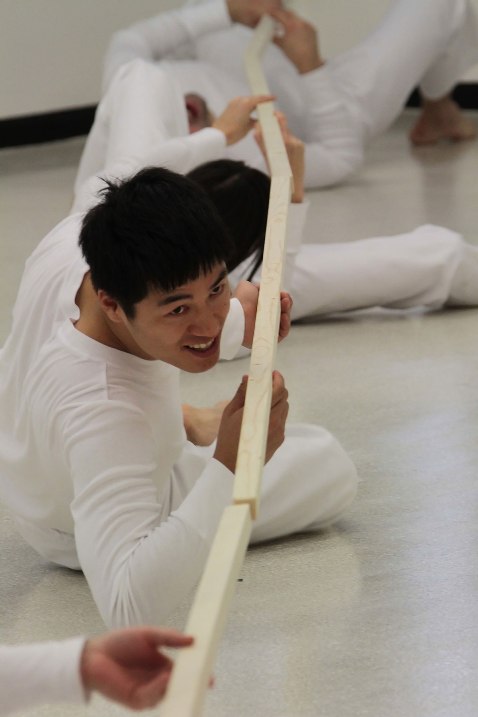

Photo: Alredo Anceschi, 2009, from www.trishabrowncompany.org.
By Sandra Orellana Sears. Read the full version of the text on Artwrit.com.
Since its inception, the Venice Biennale has expanded to become an interdisciplinary venue for all things contemporary. An ongoing international workshop for the experimental and the cutting-edge, the Biennale has transformed to include art, architecture, music, cinema, theatre and, most recently, contemporary dance. Veteran visitors will affirm that at each subsequent festival they are met with something compelling or disappointing, or perhaps something unexpectedly suspended between these two extremes. At times, the work can be shocking (like Marina Abramović's Golden Lion-winning performance Balkan Baroque, a three-channel projection of images of the artist and her family accompanied by a performance of Abramović, continuously scrubbing the meat and blood off 6,000 pounds of cow bones six hours a day for four days). Sometimes the art can be shockingly bad (Cindy Sherman's colossal wallpaper portraits at the 2011 Biennale seemed garish in the Giardini's main exhibition space). In any case, there is always a taste of everything.
While the dance sector is the youngest of all disciplines in the Biennale to date, the performers for this year's International Festival were well seasoned and did not disappoint. Titled Awakenings, the program ranged from the local to the international and back again, including Virgilio Sieni, a Tuscan choreographer who deftly intertwines the art of letters and movement, drawing inspiration from Lucretius and Borges. For this iteration of the Dance Biennale, Sieni presented a piece based on Aristotle and his treatise, De Anima. Christiana Morganti, a member of the Pina Bausch company for 18 years, offered a moving "dancing lecture" titled Moving with Pina in tribute to the eponymous German choreographer who passed away in 2009. The festival also included a concert by the Icelandic duo Lazyblood with choreography by Erna Ómarsdóttir and music by the a member of the punk ground Reykjavik!, Vladamir Jóhannsson. A mixed bag of styles and technique, no doubt.
Trisha Brown, now an old postmodern favorite among Americans and Europeans alike, was one of the more familiar names included in the program. However, it was no less exhilarating to see some of Brown's older pieces come to life in the context of the Venice Biennale, ever morphing as different companies and dancers across the globe adapt and reinterpret her choreography each passing year. The covert setting of the Teatro Piccolo Arsenale just off the Venetian lagoon also lent a mystifying element to this evening performance. As audience members casually gathered outside the pleasantly small, ornate Venetian theater, the event had the ever-so-slight feeling of a Ginsberg happening. Was this a performance? Theater? Dance? Not exactly the backdrop one would anticipate for Brown's minimalist, improvisation-driven choreography, the palatial setting in Italy's floating city left these questions unanswered, recalling Brown's own challenging of conventional settings for the dance discipline decades earlier. In the '70s, Brown astonished audiences by removing dance from theaters and recontextualizing it in unexpected, often public, places including on the surface of water and SoHo rooftops.
In the spirit of experimentation, the Dance Biennale has collaborated with students from the Teatro Scuola Paolo Grassi, currently enrolled in a Dance Theater course in Milan. For the performance of Line Up, the students relearned a series of early works by the Trisha Brown Company performed between 1976 and 1977. The students first memorized the original sequence of these choreographies, and later revised the movements based on a process of improvisation prompted by a set of instructions that Brown gave her performers at the original conception of the piece.
For audience members well versed in the lexicon of Trisha Brown's early works, the series of works that comprise Line Up will ring a bell: Sticks, Scallops, Clackers, Spanish Dance, Solo Olos, Corners and Figure 8, a selection of pieces from the 1970s that established Brown as one of contemporary dance's groundbreaking figures. Like quicksilver, the physical and psychological impact of her works change rapidly depending on the performance space (indoor versus outdoor), and on each dancer's demeanor as he or she interprets the precise progression of linear, everyday gestures broken down and pieced together again, maintaining a sense of fluid movement and continuity all along the way. Depending on the air of the performer, the premeditated movements vary from playful and sinuous in one moment, to heavy and lugubrious in the next. Most of the performance, which lasted 45 minutes, was unencumbered by music. The soundtrack was generated only by movement itself: the squeaky shuffle of bare feet, the rattle and slap of wooden sticks against the stage, labored breath and wispy limbs gliding through heavy, humid air. At one point, the clear, steady clap of a metronome shot between the theater walls.
Only one piece -- Spanish Dance -- employs a musical accompaniment: none other than Bob Dylan's cover of Gordon Lightfoot's folk ballad "Early Morning Rain." Usually, it is song that inspires the movement of dance, but Brown's interpretation of this simple, ubiquitous tune transforms it into something otherworldly, reversing the order of operations. As Dylan's tune unfolds, the first dancer swings her hips to the steady tempo of the harmonica and guitar, raising her arms overhead in a seductive, hula-like flourish as if the old ballad were some exotic flamenco composition. With a steady swagger, she inches slowly but methodically towards the next performer until their hip points meet front to back, creating a magnetic train of corporal locomotion. Always looking out towards the audience, they maintain an ethereal gaze as their hips synchronize in a lazy wag, slowly inching towards the opposite end of the stage until all five dancers are nestled together in a single swaying flutter of limbs, one unit of movement deconstructed and put harmoniously back together again. The progression is perfectly timed to the duration of the song, culminating with five dancers compressed into a tight, undulating bundle against the far wall of stage right. When the song ends, the remodeled shape of their united bodies, joined together by the structure of song, emanates a fanciful quality.
A tip of the hat to an eternal muse, the Palao Grassi company certainly does justice to Brown's lasting impact on the continuous evolution of the contemporary dance discipline. But in the end, Trisha Brown never gets old -- their reinterpretation of her early works is a more-than-welcome reprise.
Line Up
21-22 June, 2012
Teatro Piccolo Arsenale
Venice